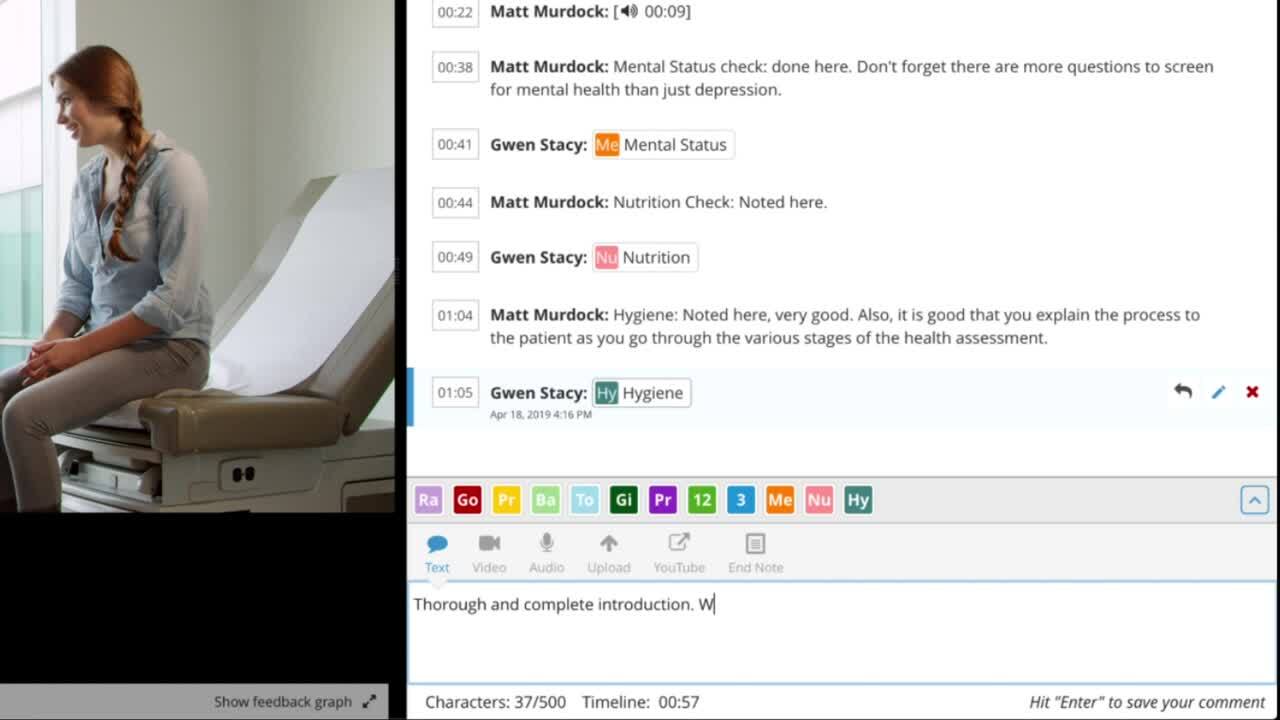A head-to-toe assessment is a staple in the nursing profession. A NCSBN survey found that newly licensed RNs performed 3.98 physical assessments during their last shift.
But are newly minted graduates prepared to do a head-to-toe assessment?
Not many.
According to a study published in Nursing Education, “only 11 of 40 RN graduates entering the transition program scored 70% or better on physical assessment skills testing.”
What’s to be done? Well, here are seven tips for nurse educators preparing students to perform head-to-toe assessments.
1. Present a Clinical Perspective
Start by contextualizing physical assessments and making it real. Students may be tempted to see it simply as an assignment—a skills check-off. To avoid that perspective, it’s important at the beginning to illustrate the purpose and how often these students will perform health assessments once they’ve entered the workforce. In other words, give the big picture for the head-to-toe assessment.
To make this learning experience interactive, build a class discussion with these types of questions:
- What’s the purpose of a physical assessment in healthcare?
- Where do most health assessments take place?
- When will you be performing a physical exam?
- How often will you do them?
- What tools will you need?
- What documents will you be filling out?
- What are the most common physical assessment tasks a practice will ask you to perform?
You don’t have to ask these exact questions. In fact, if you want it to be a little more informal, you can create pairs or small groups for students to act like journalists by discussing the how, who, what, why, when, and where.
More Ideas
Another great way to make health assessments real is sharing your own personal experiences and stories. It can be a funny story, or it can be a more serious example where you made a mistake. Whatever story you share, it contextualizes, humanizes, and prepares students for what head-to-toe assessments look like in a clinical setting.
If you’re not much of a story teller, you can ask professional nurses to come in and share their experiences. You can even have a panel with visitors! Perhaps each visitor tells a story illustrating the different ways physical assessments are performed in health care.
2. Debate/Discuss Your Head-to-Toe Checklist
After contextualizing the health assessment, it’s tempting to quickly hand out the head-to-toe skill check-off rubric. Wait! Take a more active learning approach that makes students think and consider why they’re doing each item on the rubric.
Instead of passing out one rubric, pass out two rubrics: an extended head-to-toe assessment checklist and a basic head-to-toe assessment checklist.
Ask students to remember the last time they had a head-to-toe performed on them when they went to the doctor’s office. How does their experience compare with the two rubrics you’ve provided?

Then split up the extended rubric items among your students. Each student can investigate and quickly present half a dozen specific tasks on the list. From there, students can debate which tasks to include on their rubric.
Prompt: Should our rubric should include the 100+ items from our nursing textbook? Or in this course, should we just focus on the most commonly performed items for a head-to-toe assessment?
More Ideas
To best illustrate the debate, give your students two rubrics to examine by downloading our Head-To-Toe Assessment Checklist.
The basic rubric in this download is inspired from a study by Dr Jean F. Giddens. She found that out of the 126 items listed on her survey, nurses at entry-level practices only regularly performed thirty of those skills when administering a health assessment. Since Dr. Giddens study, others have reinforced these results with similar findings.
It’s important for nurses to know basic head-to-toe assessment, but that’s not to say that they shouldn’t learn the 100+ skills rubric. That’s why the second rubric in the download includes the skills in a head-to-toe assessment checklist for more rare situations and/or are often specific to practice categories (e.g., psychiatric, pediatric, and emergency).
By debating and looking at these two rubrics, your students no longer see an arbitrary list of checkboxes to practice, memorize, and perform.
3. Demonstrate Physical Examination Methods
After contextualizing the physical assessment and discussing your rubric, you’ll want to focus on the psychomotor skills that make up a head-to-toe assessment: inspection, palpation, percussion, and auscultation.
According to the American Journal of Medicine, 76% of cases resulting in missed or delayed diagnoses were due to inadequate physical examinations. Focusing on physical examination methods decrease the probability of misdiagnosis and improve patient safety. So in order to bridge the theory-practice gap in nursing, it’s imperative to educate nursing students on physical examination methods.
Physical examination methods follow a sequence, beginning with a general inspection that increases in detail. The following overview—from the third edition of Health Assessment and Physical Examination—thoroughly describes the four physical examination methods and what each entails.
Inspection
Performed first, inspection is the most repeated of the four physical examination methods. Teaching students about inspection emphasizes using sight and smell to check specific areas for normal color, shape, and consistency.
Sight
Make sure that your students arrange clothing accordingly and use adequate lighting to fully observe the body parts they are inspecting.
Smell
Because certain infections give off a stench, smell is vital to inspection. You may simulate smell by using a scent-laden cheese (as done in this study) to give students real-life experience with smell inspection.
Palpation
Palpation is the act of touching a patient to feel for abnormalities anywhere in the body. There are two different types: light and deep palpation.
Light Palpation
As the name suggests, light palpation is soft and gentle. Nurses may find information on skin texture and moisture, masses, fluid, muscle guarding, and superficial tenderness by using light palpation.
Deep Palpation
Deep palpation explores the body’s internal structures to a depth of 4-5 centimeters. This technique can inform nurses about the position of organs and masses, as well as their size, shape, mobility, consistency, and areas of discomfort.
Have students role-play using different scenarios to train them to palpate effectively. Encourage short fingernails and warm hands to boost patient comfort during palpation.
Percussion
Percussion includes tapping one’s hands on a patient’s body to produce sound vibrations. The sounds made can confirm the presence of air, fluid, and solids, along with organ size, shape, and position. Percussion can be practiced almost anywhere to analyze the intensity, duration, pitch, frequency, quality, and location of sound.
Here are a few at-home percussion practice ideas for your nursing students to try:
-
- Percuss two glasses—one filled with water, the other empty. Compare the sounds.
- Percuss the wall of a room and listen for the change in tones when a studboard is reached.
- Percuss your thigh. Puff your cheeks and percuss them. Compare the sounds.
Auscultation
The final method is auscultation, which is listening to the heart, lungs, neck, or abdomen to gather information. There are two types of auscultation: direct and indirect.
Direct Auscultation
Listening with the unaided ear. This may include listening to the patient from a distance or right on the patient’s skin.
Indirect Auscultation
Using amplification or a mechanical device, such as a stethoscope. An acoustic stethoscope does not amplify the body sounds but blocks out environmental sounds.
John Finley stated, “Hearing is a sense, but listening is a skill that can be improved.” Studies show remarkable improvement in the accuracy of heart murmur assessments through repetition. Help your students master auscultation through repeated practice. Students may pair off and practice on each other, switching back and forth.
4. Assign a Script
They’ve got the psychomotor skills down, now your students need to put it into a narrative. Assign your students to write a script for the head-to-toe assessment—tell them that they’re creating a script for a movie, and they’ll be more motivated to play the glamorous roles of screenwriter and director.
It’s helpful to think of this assignment in terms of narrative and dialogue.
Narrative
With so many items to check off in a physical assessment, it’s easy to forget one or two things. By writing a script, students organize the story of a head-to-toe assessment in an order that makes the most sense to them. When the story of a head-to-toe makes sense, it’s easier to remember every step and not leave something out.
Discuss the different ways they can organize health assessment checklist items. For example, their narrative could revolve around working their way from head to toe. Or they could organize by a patient’s position—supine, sitting, etc.
Dialogue
Students can write out the conversation between the patient and the nurse to reinforce that this is more than working through a checklist. It’s an interaction with a real person.
Students can easily focus too much on the psychomotor skills and forget about the human interaction of a physical assessment. This assignment can imbue students with confidence and perhaps even save them from the embarrassment of being tongue-tied the first time they role play. They can draft, revise, and memorize phrases they’ll say to the patient.
More Ideas
Encourage students to consider various scenarios. Would they phrase things differently if they’re dealing with a cranky patient or a squirmy twelve-year-old?
Also, as with any writing assignment, it’s always a great idea to engage students by doing a peer review. Have students share their scripts with a partner and then give their partner feedback. Maybe their partner found a better way to ask a patient “to assume a supine position.” Who knows?
5. Flip Your Classroom
The flipped classroom is a successful strategy for promoting active learning in the nursing classroom. If you’re not familiar with the term, a flipped classroom just switches the items traditionally done at home and in the classroom.
Instead of using class time to lecture or watch demonstrations, students watch lectures or demonstrations at home. Then they use class time to practice the skills they learned at home. A flipped classroom is all about mediated practice—and that’s why it’s a perfect exercise for teaching the head-to-toe assessment.
To use this technique, simply record your lecture or send students a recorded head-to-toe demonstration. After watching this at home, when they come to class they role-play performing a physical assessment. You can roam the room and give individual and collective feedback.
More Ideas
If you upload a short lecture and a head-to-toe assessment demonstration, consider uploading an imperfect example. With an imperfect physical assessment, you can assign students to identify items done well and items that were skipped or performed incorrectly.
At the beginning of class, have students write their findings on the board. Quickly review their findings with them so students start to think critically. This will model how they can extend this reflection and critical thinking during their role-playing.
If you’re still nervous about trying a flipped classroom, read “5 Simple Steps to Create Your Own Flipped Classroom.”
6. Assign a Student Head-to-Toe Assessment Video
Another clever way to use video to close the preparation-practice gap is assigning a student head-to-toe assessment. Simply ask students to record themselves performing a health assessment on a friend or fellow classmate. Students then submit the video to you and you provide individual and specific feedback.
Utilizing student videos to teach nursing assessments provides the following benefits:
Flexibility for students and faculty
Students don’t have to rely on a rare simulation lab opening to record their head-to-toe assessment. They just need their smartphone propped up against some books and a willing participant to be the patient.
More opportunities for practice
If students performed a nursing head-to-toe assessment in a simulation lab, they would only get one chance. But with a student head-to-toe video assignment, your students can record themselves as many times as they want and turn in their best take.
Students see their mistakes
With this assignment, students are faced with irrefutable evidence of their mistakes. That’s one of the reasons research shows that when students see their mistakes visually, they learn skills crazy fast.
Students can correct their mistakes
Your students can watch their videos immediately and compare their performance with the head-to-toe assessment checklist. This makes students more self-sufficient and more prepared.
More effective debriefing
Even relying on primitive recording technology in 2003, research published by Central Missouri State University baccalaureate school of nursing (CMSU) noted the improved quality of their feedback by responding to student videos.
Increased student confidence
Practicing more and being able to watch their practice gives your students more confidence in performing a nursing head-to-toe assessment.
More self-reflection
Self-reflection is a hard skill to teach students, but you will notice increased awareness as students record, practice, and review their recordings of performing a head-to-toe assessment.

More Ideas
The results improve even more if you use the right video software, and we’d recommend using GoReact. Utilizing video technology in education can be tough, whether it’s figuring out how students will access video recording technology (the university video lab or cell phones), determining how students will turn it in (flash drive, online website, cloud software), making sure you’ve downloaded compatible software to watch all the student submissions, or devising an effective accompanying feedback method (google docs, excel, or word).
GoReact is a video assessment tool that can solve the headaches that come with assigning a health assessment student video. Here’s how:
- Smaller video files: Video submissions are automatically compressed and accessible to the professor.
- Simple Equipment: Students can film themselves with their own smartphones and laptops. Students can access easy-to-use tools to pause, clip, or re-film a segment.
- Integrated Feedback: Professors can give time-stamped feedback and use customized markers.
- Accessible Feedback: Immediately after a professor finalizes their review and releases it, students can access and respond directly to their professor’s feedback.
So the right tool can help mitigate historic challenges in assigning a head-to-toe assessment video. Also keep in mind that even in the early 2000s, nursing educators believed the benefits of a student video health assessment far outweighed these early challenges. That means there is even less reason for nursing educators today to not employ the student video for the physical assessment in nursing.
Whether you use GoReact or another video tool, nursing professors must seriously consider video to help bridge the gap in teaching the nursing head-to-toe assessment.
7. Finish with Simulation
By following these tips, you’ll provide your students with a clinical perspective, a script to follow, and psychomotor skills they’ve practiced and refined with rounds of peer and instructor feedback.
Now it’s time to put those skills into a clinical context. In other words, your students will be ready for simulation. In truth, simulation is an excellent way to ensure improvements to that shocking study this article started with: “only 11 of 40 RN graduates entering the transition program scored 70% or better on physical assessment skills testing.”
One piece of advice: make sure you meet simulation standards. To check if you’re in line with best practices and state standards, watch a free workshop with INACSL about simulation standards or read “3 INACSL Approved Strategies To Up Your Simulation Game.”
More Ideas
If you have a video assessment software—like GoReact—use it to enhance simulation debriefings. Many programs use it for this exact purpose. Video assessment software offers advanced feedback tools: time-coded feedback, multimodal feedback, customizable markers, embedded rubrics, and more. Take advantage of these advanced feedback features by simply uploading your simulation videos directly into the video assessment software.
If you to see just how easy it is to use GoReact for your health assessment, read “5 Steps to Save Time Conducting Basic Head-To-Toe Assessments.”






